Benchmark Results: PCMark Vantage Storage Test
PCMark Vantage comes as close as we get to approximating real-world performance using a synthetic benchmark. The Application Loading metric measures disk drive performance while loading Microsoft Word 2007, Adobe Photoshop CS2, Internet Explorer 7, and Outlook 2007.
This is just the beginning of the trend, but notice that both disk drives fall to the back of the line. Even Western Digital's VelociRaptor can't keep pace.
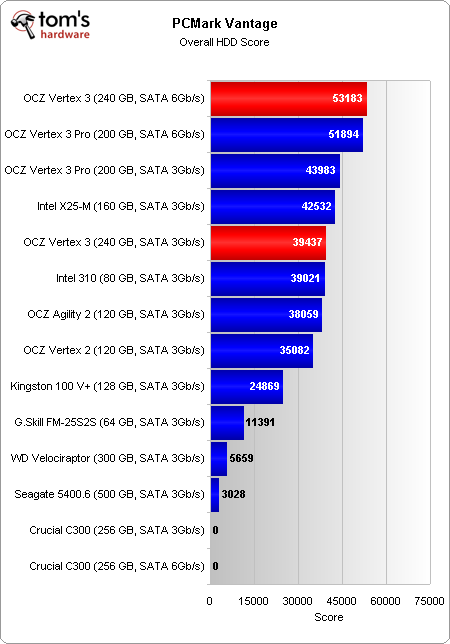
While PCMark Vantage is the closest thing to showing real-world performance, it has its own flaws. As in our Vertex 3 Pro coverage, we see about 5000 PCMark variance in the final score when we rerun the test. We noticed that the drive would either perform outstanding in Windows Defender or Application Loading, but never both. We have seen variances with PCMark in the past and this is well within those tolerances, but it is something we wanted to mention for those curious about our numbers. Furthermore, we were unable to get the C300 to finish a complete run, which is why we lack a overall HDD Suite score.
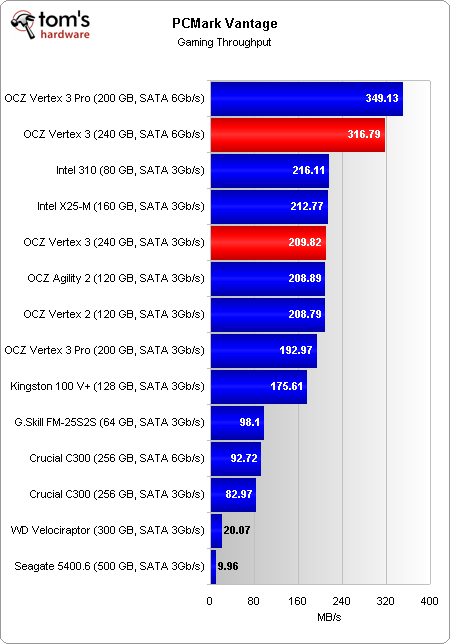
Using >99% streaming reads, Vertex 3 nearly hits the same speeds as the Vertex 3 Pro. However, this doesn't come anywhere near the drive's peak specs.
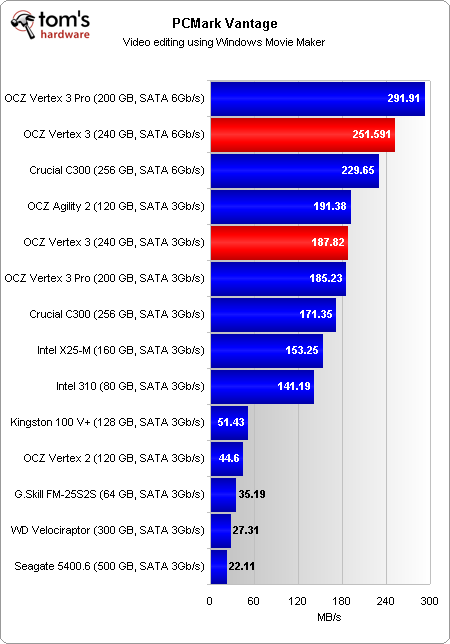
The video editing test is split more evenly between reads and writes. This time we see the Vertex 3 continuing to trail the Vertex 3 Pro. Crucial's C300 follow closely behind.
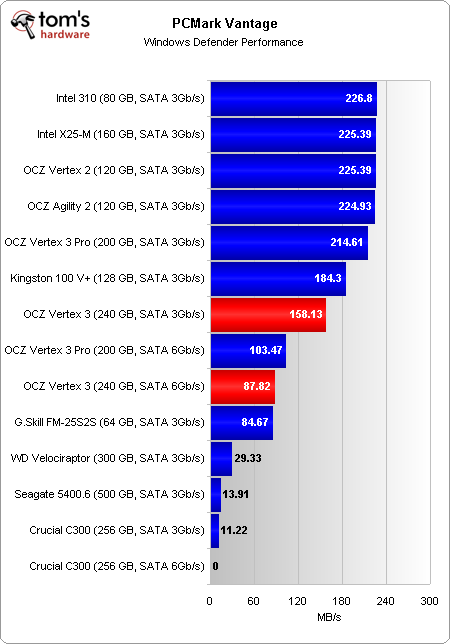
As we already mentioned, the Windows Defender benchmark shows a lot of variance when we start testing the C300, Vertex 3, and Vertex 3 Pro in a SATA 6Gb/s configuration.
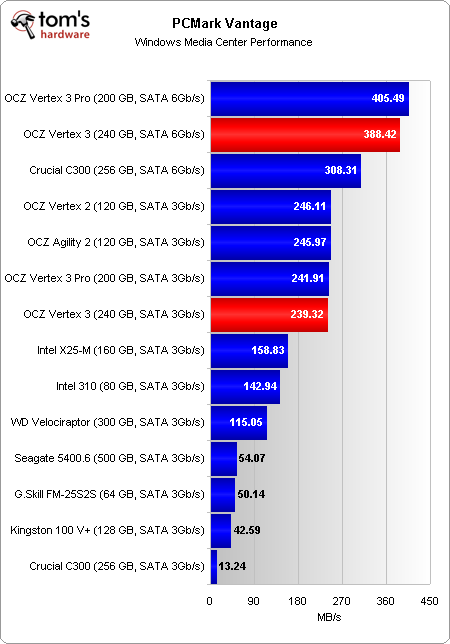
The Windows Media Center test runs SD video playback, SD video streaming to an extender, and records an SD video concurrently, yielding an even split between reads and writes. This time we finally see the Vertex 3 punch through the bandwidth limitations of SATA 3Gb/s.
Get Tom's Hardware's best news and in-depth reviews, straight to your inbox.
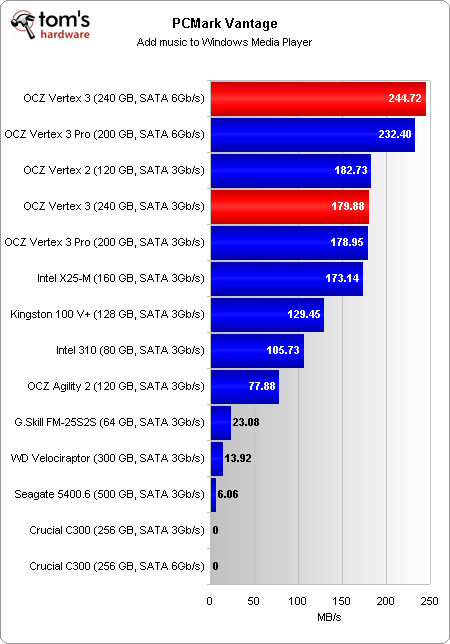
SandForce drives typically do very well in read performance, and we see it here. Notice the progression from SandForce to Intel to older drives.
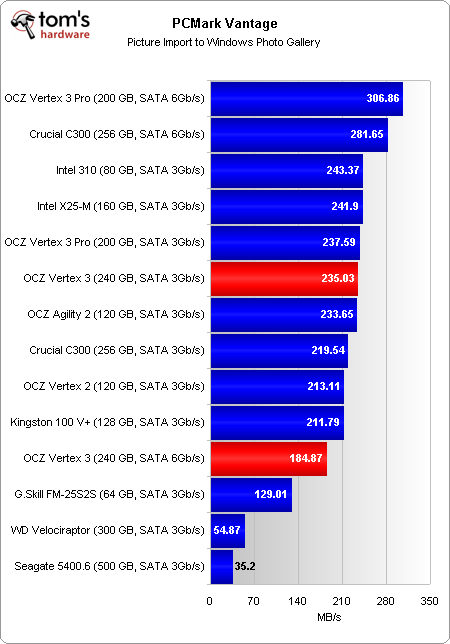
The photo import test is also mostly read-based, so it isn't a surprising to see the Vertex 3 fall behind. We should point out at this benchmark also shows quite a bit of variation.
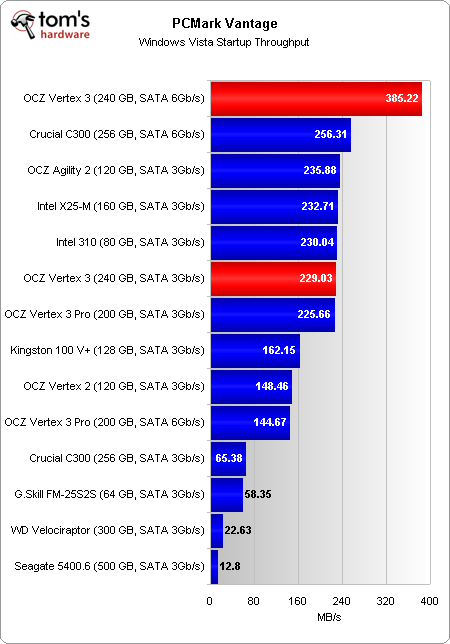
OCZ tops the chart again. Remember that this is naturally almost all read-based.

Current page: Benchmark Results: PCMark Vantage Storage Test
Prev Page Benchmark Results: 4 KB And 512 KB Random Writes Next Page Benchmark Results: Power Consumption-
lradunovic77 I agree and it is time for HDD to be retired. We don't need them anymore, but Servers.Reply -
bildo123 A far cry as far as "the masses" are concerned. Still, over $2/GB is too much. Getting closer however. I'd pay $200 for a 256GB SSD with these speeds.Reply -
acku mayankleoboy1the fact that they use ~15% of a quad core SB CPU, is amazing.with the mechanical drives, they were just sitting idle. this more than anything, makes the SSD worthwhile.Reply
Well what I didn't mention in the review is that the benchmark starts as ~20% across all cores during the first 10 seconds, which is from PCMark setting up the disk trace. After that, the IO activity throttles a single core up to 100% for almost all SSDs. For the hard drives, we see ~60-80% utilization of a single core.
Cheers,
Andrew Ku
TomsHardware.com -
lradunovic77 I say keep your desktop active all the time. I am running i980x overclocked to 4.0Ghz and there is no way i will put my computer into any type of power saving mode, it is useless and power saving is just mimick. We are talking about very small amount of money over a year. Having Turbo option makes sense from certain point of view but bottom line is that it is just wasted silicon and pretty much useless.Reply -
vvhocare5 "The problem is that any price above $2/GB is going to be a hard sell unless you're an early adopter by nature. Our choices in recent System Builder Marathon stories reflect this. Look at our December $1000 PC."Reply
Overall a good article. Anyone into MTBF's will find that one page uninforming and anyone not into it is likely lost.
I would disagree with that statement only in the sense that a $1000 PC is not going to be filled with high-end superior performing parts. So I dont see a reason to apologize for its price. The person who can afford a $3000+ PC isnt going to blink buying the 240G model and will likely see it as entirely reasonable.
Me? I think I have found my next ex-drive.....
-
acku Replyso as i said, will OC increase the scores a bit?
and what about power saving enabled?
None of our tests were executed in an environment that allowed any idling. Furthermore, we disabled CPU throttling. Power saving was enabled in the sense that the display was allowed to turn off, which is part of the default profile in Windows.
OCing may increase performance, but only to the extent that the bandwidth will support it. As I mentioned, PCMark throttles a single core up to 100%. It isn't a sustained trend. -
bto on your 1000 dollar gaming system, I'd rather have a vertex 3 than two 460's hell even an agility 2... and still afford better than a 460.Reply -
bto But then that's me, and to quote the great Inigo Montoya, "I hate wait" and most games I play are not bleeding edge, I also work on my computer, play HD movies and copying time makes me angry when I'm moving files. Buy an ssd, and later spend 60 bux on a 1tb drive down the road.Reply